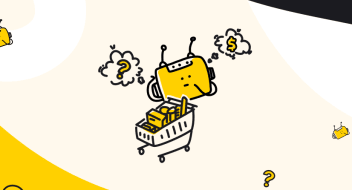Showing top 0 results 0 results found
Showing top 0 results 0 results found

Are you looking to streamline your daily tasks and interactions? Chatbots are rapidly becoming integral to how we communicate, providing solutions to everyday challenges.
With technology advancing rapidly, by 2024, chatbots are expected to save businesses up to 2.5 billion hours of work, highlighting their increasing impact on productivity and service delivery.
In this article, we will explore some of the best chatbot use cases that you can benefit from in your everyday life, including:
- How chatbots can manage your appointments.
- Enhancing customer service experiences.
- Simplifying online shopping.
- Providing real-time travel updates.
- Offering personalized learning experiences.
What is a chatbot?
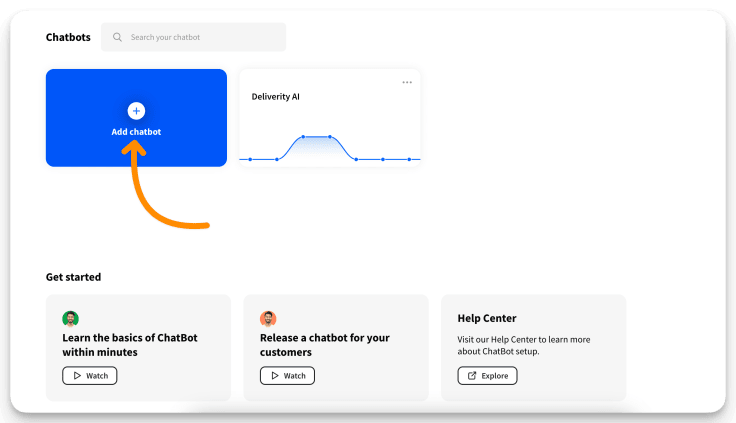
A chatbot is essentially a software application built to chat with users, mimicking human-like conversations. It uses AI to interpret and respond to messages, making interactions as smooth and natural as possible.
Chatbots operate on a blend of artificial intelligence technologies, including natural language processing (NLP), machine learning (ML), and natural language understanding (NLU). This allows them to grasp and process user queries accurately.
Whether it's on your favorite messaging app, website, or voice assistant, chatbots are there to offer quick answers and help perform a variety of tasks. For example, they can assist with everything from booking appointments, fetching information, or providing customer support. What makes chatbots even more impressive is their ability to learn from interactions to improve over time, ensuring they become more helpful the more you use them.
One excellent example is ChatBot, which provides a robust platform for businesses to deploy chatbots without needing any coding skills. This tool scans your existing resources—like your website or help center—to deliver accurate and swift responses directly to your customers, enhancing their experience and your efficiency.
Not sure where to start?
Read more about interesting chatbot ideas for your business.
Benefits of using a chatbot
Chatbots transform the way businesses interact with customers.
Here’s how:
- Round-the-clock service: Customer support teams benefit greatly as chatbots don't sleep, continuously assisting with customer queries anytime. This is perfect for after-hours support or for global businesses across different time zones.
- Streamlined customer support: Support agents are aided by chatbots that can manage numerous customer queries at once, significantly cutting down response times and boosting overall satisfaction across customer support channels.
- Cost efficiency: Automating standard queries and tasks with chatbots means you can save on the expenses of training and maintaining a large customer support team.
- Enhanced productivity: By handling routine inquiries, chatbots free up human agents to tackle more complex issues, boosting your team's efficiency.
- Customized interactions: Chatbots can tailor conversations based on a user’s past interactions and preferences, making each engagement feel more personal.
- Easily scalable: During peak times or company growth, chatbots can handle the increased load without a hitch.
- Insightful analytics: Through data analytics services, chatbots collect data that offers invaluable insights into customer preferences and behavior, aiding in refining services and marketing strategies.
Best chatbot use cases
Chatbots have become versatile tools in various industries, streamlining processes and enhancing user experiences.
Here are some of the best use cases for chatbots:
- Order and refund processing
- Product recommendations
- Order confirmation and tracking
- Customer feedback collection
- 24/7 support
- FAQs responses
- Appointment scheduling
- Voice assistance
- Customer engagement
- Real-time travel assistance
- Social media engagement
- Customer onboarding
- Patient data collection
- Quick medical assistance
- Mental health care
- Medication reminders
- Financial advice and insights
- Account analysis
- Expense tracking
- Balance and bill notifications
- Suspicious activity alerts
- Hotel room personalization
- Insurance claims processing
- Internal help desk
- Onboarding and training
- Lead generation
- Chatbot marketing
One chatbot platform to build them all. Discover the potential of ChatBot today.
Ecommerce chatbot use cases
Ecommerce chatbots serve as dynamic tools in online shopping, streamlining operations and boosting customer satisfaction.
Let’s explore their key functionalities in greater detail.
Order and refund processing
In ecommerce, the efficiency of processing orders and handling returns directly impacts customer satisfaction and loyalty. Chatbots excel in this area by facilitating smooth and swift transactions. When a customer places an order, a chatbot can immediately guide them through the payment process, provide additional product information, and upsell related items, all within the same interaction. This seamless integration can significantly boost conversion rates.
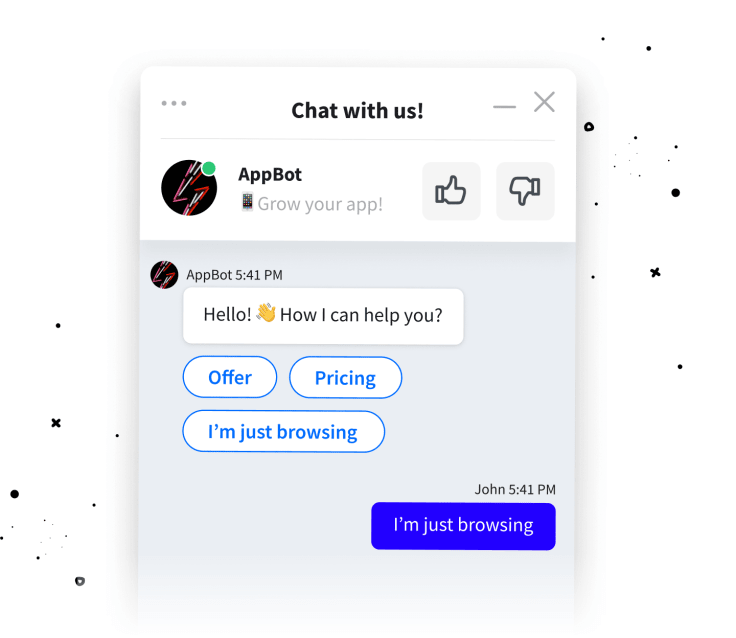
On the return side, chatbots simplify the process by interacting with customers to ascertain reasons for returns, guiding them through the steps to successfully return a product, and automatically updating their return status. This automated process removes the often frustrating back-and-forth communication typically associated with returns, making the experience more straightforward and customer-friendly.
Imagine a scenario where a customer wishes to return a product they bought online. A chatbot could handle the interaction by asking for the order number, reasons for the return, and preference for refund or replacement, all while providing packaging and shipping information. This chatbot then schedules a pickup time that suits the customer, completing the process efficiently without any human intervention.
Product recommendations
Chatbots are incredibly effective at enhancing shopping experiences through personalized product recommendations. By analyzing a customer's browsing behavior, purchase history, and even their interactions during the shopping process, chatbots can suggest items that truly match the customer's preferences, increasing both customer satisfaction and sales.
Consider a customer shopping for books online. A chatbot could recommend books based on the genres the customer has previously explored or purchased. If the customer shows interest in historical fiction, the chatbot might suggest the latest bestsellers in that genre, books by similar authors, or even upcoming titles with special pre-order prices. This makes the shopping experience more personalized and helps the customer discover products they might not have found on their own.
Order confirmation and tracking
Using chatbots for order tracking and updates can greatly enhance transparency and trust in an ecommerce platform. Right after a customer completes a purchase, a chatbot can send an instant confirmation message along with details such as the order number, expected delivery date, and a summary of the order items. As the order progresses through packing and shipping, the chatbot continues to send updates, which can significantly reduce customer anxiety about their purchase.
Imagine a customer who orders a high-value electronic item online. A chatbot could provide them with regular updates at each step of the process: when the item is packed, shipped, and out for delivery. Additionally, the chatbot could provide a tracking link and options to change delivery preferences, ensuring the customer feels in control of the process.
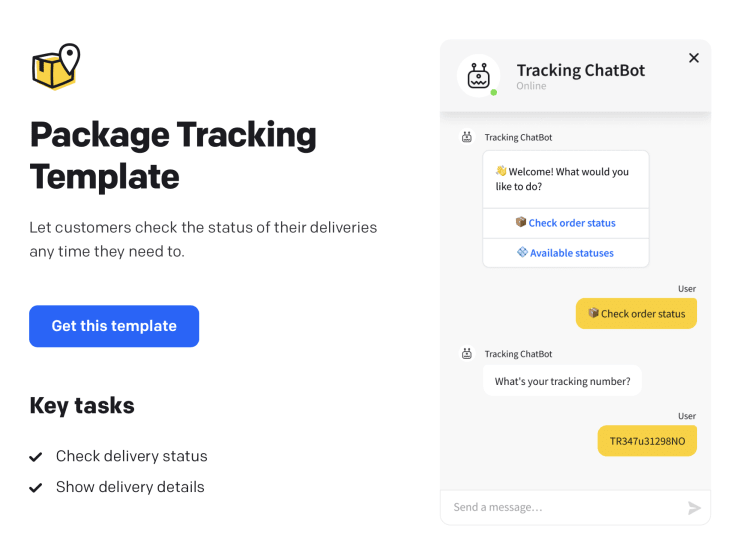
Customer service chatbot use cases
Chatbots are transforming customer service by offering faster, more efficient support and personalizing interactions based on user needs. Let's explore some of the most impactful chatbot use cases in customer service.
Customer feedback collection
Collecting customer feedback is crucial for any business aiming to improve its services and products. Chatbots simplify this process by actively soliciting feedback through engaging and intuitive interfaces. For instance, after a customer interaction or transaction, a chatbot can prompt the customer to rate the service or product and provide comments on their experience.
A chatbot could also offer incentives for completing feedback forms, such as discount codes or entry into a competition, which can increase participation rates. Moreover, the chatbot can analyze the collected data in real time to identify trends and areas for improvement, enabling businesses to react quickly to customer needs and preferences.
For a more tangible example, imagine an online retailer using a chatbot to gather feedback after each purchase. The chatbot asks a few short questions about the buying experience, product satisfaction, and delivery service. This immediate, easy-to-complete form not only feels less intrusive but also yields higher response rates, enabling the collection of customer feedback that provides retailers with valuable insights to continuously enhance service quality.
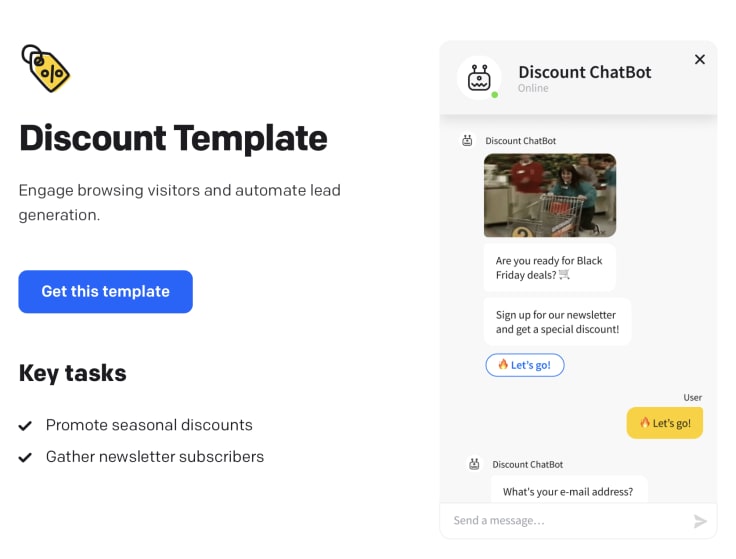
24/7 support
Offering 24/7 customer support through chatbots ensures that help is always available, regardless of the time or day. This is especially important in our increasingly globalized world, where customers may be in different time zones or prefer shopping during off-hours.
Chatbots can handle various common inquiries—from tracking order status to troubleshooting simple product issues—without human intervention. If a query is too complex, the chatbot can escalate it to human agents, ensuring the customer still receives a prompt response. This improves customer satisfaction and reduces human agents' workload, allowing them to focus on more complex issues.
Consider a scenario where a customer faces a problem with an electronic device late at night. The chatbot can guide them through basic troubleshooting steps. If the issue isn't resolved, the chatbot can schedule a service appointment or ensure that a customer service agent contacts the customer as soon as one is available.
FAQs responses
FAQ chatbots efficiently handle frequently asked questions, responding instantly to common queries. This capability significantly enhances the customer experience by reducing wait times and freeing up human agents to deal with more complex issues.
A well-designed chatbot can be programmed with a comprehensive list of FAQs and use natural language processing to understand and respond to customer inquiries accurately. For example, a chatbot on an ecommerce site might answer questions about return policies, payment options, and shipping details.
In a hypothetical application, a chatbot deployed by a telecommunications company could instantly provide data plan options, troubleshooting steps for service disruptions, and information on how to upgrade services. This would deliver immediate value to the customer and reduce the call volumes experienced by human agents.
Appointment scheduling
Chatbots excel at scheduling appointments. They offer a user-friendly interface that lets customers select dates and times without the need for direct interaction with support agents. This system can be integrated with the business’s calendar, allowing the chatbot to offer real-time availability and immediately confirm bookings.
An example of this could be a healthcare provider where a chatbot allows patients to book, reschedule, or cancel appointments. The chatbot can remind patients of upcoming appointments and provide preparation instructions or directions to the clinic, enhancing the overall patient experience.
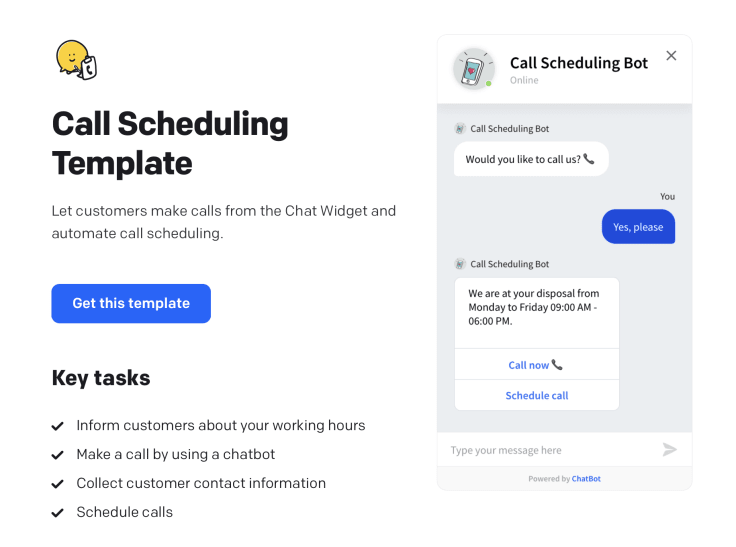
Voice assistance
Voice-enabled chatbots represent a significant advancement in making digital interfaces more accessible, particularly for users with visual impairments or those who prefer voice commands over typing. These chatbots use speech recognition technology to understand and respond to voice inputs, making them ideal for hands-free interactions.
For instance, a voice-assisted chatbot in a smart home environment can control lighting, temperature, and security systems based on the user's voice commands. This provides convenience and enhances accessibility for users with physical disabilities.
Customer engagement
Chatbots are powerful tools for engaging customers. They can send personalized messages based on customer behavior, preferences, and previous interactions. This proactive communication can help businesses promote new products, special offers, or events to relevant audiences.
A hypothetical use case might involve a chatbot for a retail clothing store that sends a message alerting customers about a newly arrived collection that matches their style preferences. This proactive approach boosts sales and enhances customer loyalty by showing attentiveness to individual customer preferences.
Real-time travel assistance
For travelers, real-time assistance is crucial, especially when it comes to last-minute itinerary changes or travel disruptions. Travel chatbots can provide instant updates on flight status, gate changes, and even alternative travel arrangements if necessary.
Imagine a traveler stuck at an airport due to a canceled flight. A travel service chatbot could immediately inform them of the cancellation, suggest alternative flights, and assist with rebooking, all through a simple, conversational interface. This kind of support can alleviate stress for travelers and improve their overall travel experience.
Create any chatbot you want with our platform.
Chatbot use cases in retail
Retail chatbots are not just about automating responses but about creating a more engaging, personalized shopping experience for website visitors.
Let's explore how they're making a difference.
Social media engagement
Retail chatbots on social media platforms can significantly enhance customer interaction and brand visibility. These bots can engage website visitors on messaging platforms, answer initial queries, and capture contact details for follow-up by sales teams, enhancing the customer journey.
For instance, a retail chatbot can automatically respond to comments on posts or direct messages, providing product information, answering queries, and redirecting users to the store’s website for further actions.
Moreover, chatbots can run interactive campaigns such as quizzes or polls directly through social media platforms, engaging users and gathering valuable customer preferences and feedback. This data can be used to tailor marketing strategies and product offerings, making campaigns more effective and customer-focused.
An example could involve a retail chatbot deployed on a platform like Instagram. It could automatically interact with users commenting on posts, ask engaging questions, and offer personalized shopping suggestions based on the user's interaction history and preferences. This proactive approach helps maintain a vibrant and interactive brand presence.
Customer onboarding
Customer onboarding is critical in retail, especially when introducing customers to new services or loyalty programs. Chatbots can simplify this process by providing new customers with all the necessary information about how to best use the services, the benefits of loyalty programs, and guidance on navigating the online store.
A chatbot can lead a new customer through the registration process, explain the points system of a loyalty program, and highlight special offers or benefits available. It can also answer any questions the customer might have about the service, improving their understanding and engagement from the outset.
For instance, a chatbot could guide a new customer through the process of signing up for a loyalty program, explaining the tiers, rewards, and how to earn and redeem points. This helps in educating the customer and enhances their engagement and loyalty to the brand.
Chatbot use cases in healthcare
Chatbots for healthcare are improving patient care by providing timely information, reminders, and support. Let’s explore how these tools are being implemented effectively.
Patient data collection
Chatbots streamline the process of collecting and updating patient information, making it easier for healthcare providers to maintain accurate and up-to-date patient records. These bots can interact with patients to collect essential health information, previous medical history, and current symptoms, storing this data securely and making it readily accessible to healthcare professionals.
For example, during pre-appointment check-ins, a chatbot can ask patients to input their symptoms, medication history, and any recent health changes. The chatbot can analyze this information to prepare a preliminary report for the doctor, saving time during consultations and helping to provide targeted care.
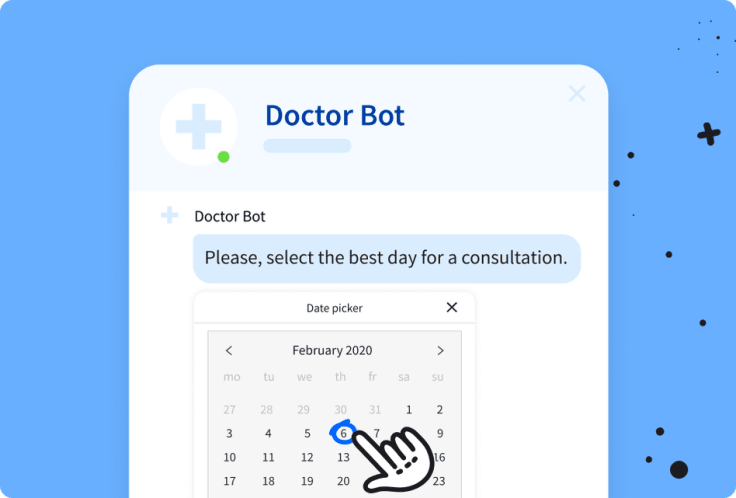
Quick medical assistance
Healthcare chatbots are invaluable for providing quick answers to general health questions, effectively reducing the workload on healthcare staff, and offering immediate support to patients. These bots can provide information on common illnesses, guidance on when to seek medical help and self-care advice.
Imagine a chatbot designed to offer first-level support, guiding individuals on home remedies for common ailments like colds or headaches and advising them on when it might be necessary to visit a healthcare professional. This immediate response system enhances patient care and can prevent unnecessary doctor visits.
Mental health care
Chatbots are increasingly used in mental health care to provide support and intervention. They can offer a conversational interface where patients can express their feelings and receive immediate empathetic responses. Chatbots can also deliver cognitive behavioral therapy (CBT) techniques, helping users manage anxiety and depression symptoms.
For instance, a chatbot could engage users daily, asking them about their moods and activities and providing suggestions or exercises to help manage stress and anxiety. This consistent interaction can significantly affect the user’s mental well-being.
Medication reminders
Medication adherence is crucial for effective treatment outcomes, and chatbots can play a key role in reminding patients to take their medication at prescribed times. These reminders can be personalized based on the patient’s medication schedule and include additional information such as medication side effects and interactions.
For example, a chatbot could remind a diabetic patient to take their insulin before meals and ask them to record their blood sugar levels. These interactions ensure adherence and collect data that can be useful for ongoing treatment planning.
Appointment scheduling
Chatbots simplify the process of scheduling healthcare appointments by allowing patients to book, reschedule, or cancel appointments autonomously through a conversational interface. This system can be integrated with healthcare providers’ calendars, showing real-time availability and sending automatic reminders as the appointment date approaches.
A healthcare provider might use a chatbot to handle appointment bookings. Patients can choose their preferred date and time and receive confirmation instantly. This reduces administrative workload and improves patient satisfaction by making healthcare more accessible.
Tools like ChatBot can be instrumental in deploying such chatbots, offering customizable templates and easy integration with existing systems, enhancing the functionality and efficiency of healthcare and retail services alike.

Chatbot use cases in banking and finance
In the banking and finance sector, chatbots are becoming indispensable tools for enhancing customer service and streamlining financial management processes.
Let's explore how these digital assistants are transforming the industry.
Financial advice and insights
Chatbots in the banking sector can act as financial advisors, offering personalized advice and insights based on an individual's financial data. These bots analyze user transactions, spending habits, and saving patterns to provide tailored financial recommendations, such as tips on saving money, investment suggestions, and ways to manage debt.
For instance, a banking chatbot can alert users about unusual spending patterns or suggest setting up a new savings account when surplus cash is detected. This proactive advice helps customers manage their finances more effectively and make informed financial decisions.
Moreover, these chatbots can be programmed to learn from user interactions, improving their advice over time to better match the user's financial goals and lifestyle. This kind of personalized service can significantly enhance customer satisfaction and loyalty to a financial institution.
Account analysis
Chatbots are excellent at conducting detailed account analyses, offering customers insights into their financial health. These bots can track spending, categorize transactions, and provide comprehensive reports that help users understand where their money goes each month.
For example, a chatbot could analyze a customer's spending over the past year and identify trends, such as increased spending on dining out or entertainment. It could then offer tips on budgeting and saving in those areas. This analysis helps customers make smarter financial decisions and potentially find ways to save money.
Expense tracking
Expense tracking is another critical area where chatbots are making a mark. These bots can automatically record transactions and categorize them into different expense heads, making it easier for users to keep track of their spending and manage their budgets.
A finance chatbot can remind users to record cash transactions, provide weekly spending summaries, and even alert them when they're about to exceed their budget. For business users, chatbots can track expenses related to travel, supplies, and other business costs, simplifying expense reporting and budget management.
Balance and bill notifications
Chatbots can send automated notifications about account balances, upcoming bills, and due dates, ensuring customers are always aware of their financial status. This feature is particularly helpful in avoiding late payments and managing cash flow effectively.
For instance, a fintech chatbot might notify users a few days before a large bill is due and check if they need to transfer funds to cover the bill. This proactive approach not only helps users avoid late fees but also aids in better cash management.
Suspicious activity alerts
Chatbots can instantly alert users to suspicious activities, such as unusually large transactions or login attempts from unknown devices, to enhance security in financial transactions. These alerts allow users to respond quickly, potentially stopping fraudulent activities.
A chatbot could immediately inform users of any suspicious withdrawal or transfer and provide options to freeze their account or speak with a security representative. This rapid response capability is crucial in minimizing the impact of financial fraud.
Chatbot use cases in travel and hospitality
Chatbots are revolutionizing the travel and hospitality industry by enhancing customer service and providing personalized travel experiences. Let's delve into specific applications in this sector.
Travel itinerary planning
Chatbots are invaluable for helping travelers plan and book their trips. These bots can suggest destinations, book flights, and accommodations, and even create personalized travel itineraries based on user preferences and past travel history.
Imagine a chatbot interacting with users to understand their vacation preferences, such as beach resorts, adventure activities, or cultural tours. Based on these preferences, the chatbot can suggest a tailored travel itinerary, book flights and hotels, and even recommend local experiences.
Hotel room personalization
In hospitality, chatbots can significantly enhance guest experiences by enabling room personalization. These bots can interact with guests before their arrival to set room preferences, such as temperature, lighting, and entertainment options.
For example, a guest could use a hotel's chatbot to request a room setup with specific lighting, a certain room temperature, and a selection of pillows. The chatbot could also offer additional services like spa appointments or dinner reservations, all from the same interface.
Chatbot use cases in insurance
Chatbots are transforming the insurance industry by simplifying processes and improving customer service. Here’s how they're effectively being implemented.
Insurance claims processing
Chatbots streamline the insurance claims process, making it easier and faster for customers to file claims and track their status. These bots can guide users through the submission process, ensure all necessary details are collected, and update customers on the status of their claims without any human intervention.
For instance, after an accident, a policyholder can interact with the insurance company's chatbot via their smartphone. The chatbot can ask step-by-step questions to gather all relevant information, such as the date of the incident, type of damage, and any third-party involvement. It can also request photos of the damage and automatically fill in forms based on the user’s responses.
Moreover, insurance chatbots can provide real-time updates on the status of claims, inform customers of any additional documents required, and even schedule appointments with claims adjusters. This automation reduces processing time and improves customer satisfaction by keeping policyholders informed every step of the way.
Internal and HR-related chatbot use cases
Chatbots are also making significant inroads in internal operations and human resources, enhancing efficiency and employee satisfaction.
Internal help desk
Chatbots serve as an invaluable resource for internal help desks by providing immediate assistance with IT and administrative issues. These bots can troubleshoot common problems, guide employees through software setups, and manage ticket submissions for more complex issues.
For example, when an employee encounters a software issue, they can initiate a chat with the help desk chatbot. The chatbot can ask questions to diagnose the problem and provide step-by-step guidance. If the issue cannot be resolved through the chatbot, it can escalate the matter by creating a support ticket and notifying IT staff.
This system not only speeds up resolution times but also frees up IT personnel to focus on more critical issues, thereby improving overall productivity within the organization.
Onboarding and Training
Chatbots are revolutionizing the way companies onboard and train new employees. These bots can provide engaging interactive, on-demand training sessions that can be accessed at the convenience of the new hire. They can also answer any questions a new employee might have about company policies, procedures, or job-specific tasks.
Imagine an HR chatbot that acts as a personal onboarding assistant. It guides new employees through the necessary paperwork, schedules orientation sessions, and even introduces them to team members virtually. This makes the onboarding process more interactive and helps new employees feel more welcomed and informed.
Sales and marketing chatbot use cases
In sales and marketing, chatbots are proving to be powerful tools for engaging customers, generating leads, and boosting sales.
Lead generation
Chatbots are excellent marketing lead generation tools. They can engage visitors on websites or social media platforms, answer initial queries, and capture contact details for sales teams to follow up with.
For instance, a chatbot on a real estate website might interact with visitors by asking what type of property they are interested in. As the conversation progresses, the chatbot can request the visitor’s contact information to send listings that match their preferences or to set up an appointment with a sales agent.
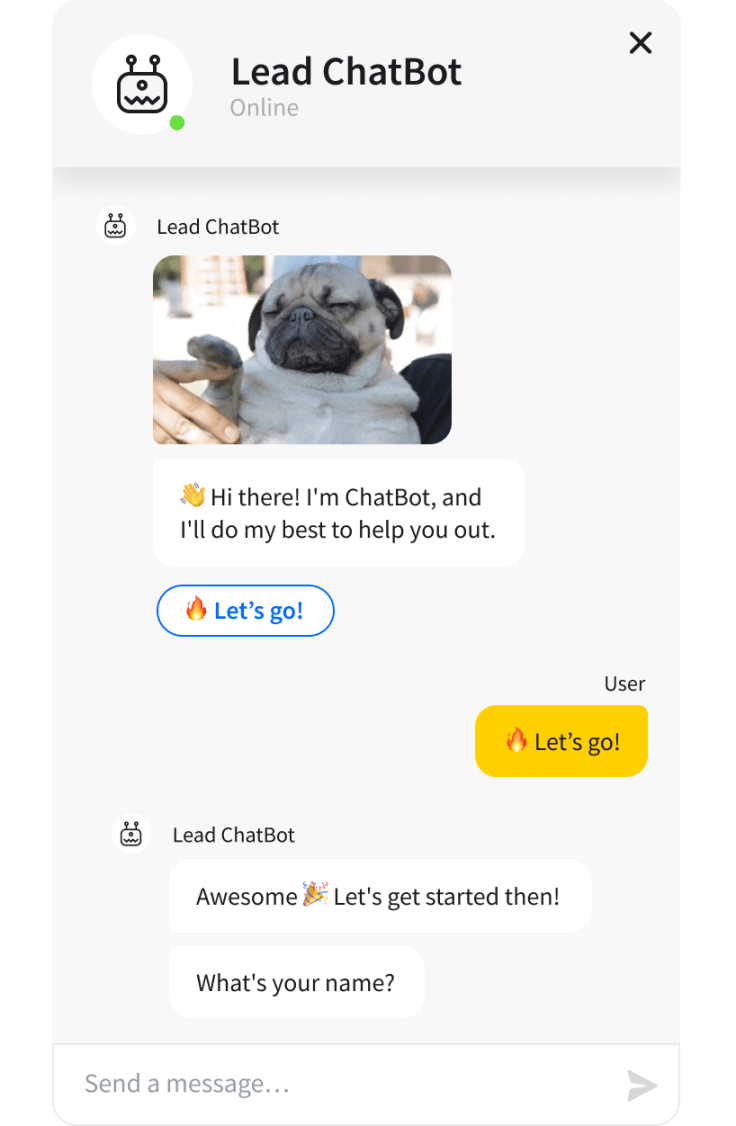
Chatbot marketing
Chatbot marketing involves using chatbots to promote products and services interactively. These bots can deliver personalized advertising messages based on user interactions and preferences. They can also launch new products, offer discounts, and collect feedback during the interaction.
Imagine a chatbot used by an ecommerce store during a major sale event. The chatbot can interact with customers, inform them about the sale, offer them special promo codes, and guide them through the purchase process, enhancing both sales and customer experience.
Increase user retention with chatbots
Chatbots help increase customer retention by keeping users engaged with timely and relevant interactions. They can send personalized messages based on past purchases, wish lists, or browsing history, remind customers of abandoned carts, and inform them about updates or restocks of their favorite products.
For example, a chatbot could remind a customer that an item they looked at last week is now on sale, or it might suggest similar items based on their browsing history. This personalizes the shopping experience and encourages repeat visits and purchases.
Best chatbots for every use case
Here are some of the best chatbots for every use case:
ChatBot
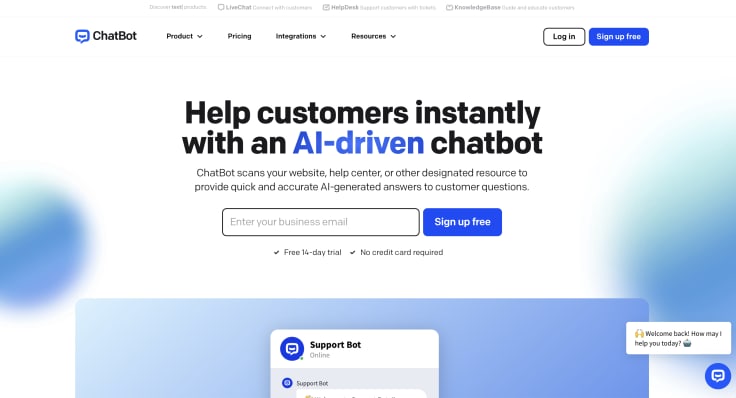
ChatBot is a robust AI-driven chatbot platform designed to deliver instant customer support by providing accurate AI-generated answers. By scanning websites, help centers, and other resources, it automates interactions without the need for third-party providers like OpenAI or Google Bard. The platform boasts a no-code, customizable framework that makes it easy for businesses to implement AI without coding skills.
ChatBot is well-suited for a range of applications from customer service to sales, offering features like standalone AI operation, quick responses, secure data hosting, and extensive integration options. Additionally, it includes a no-code chatbot builder, FAQ modules for controlled responses, and capabilities for personalized customer interactions.
Starting at $52 per month with a free trial available, ChatBot also provides templates covering nearly all the use cases mentioned earlier. It is a comprehensive solution for businesses aiming to enhance their digital engagement.
Intercom

Intercom’s chatbot is tailored for businesses of all sizes seeking a high degree of customization in their chatbots. Starting at $39 per month when billed annually, Intercom is particularly noted for its ability to support enterprise-level features like HIPAA compliance and smart lead qualification.
The platform allows for extensive customization, including logos and email templates, and offers dynamic audience targeting. Although pricing for larger businesses is custom and less transparent, Intercom enriches its service with add-ons like product tours and integrations with platforms like WhatsApp. It's designed to cater to various needs from support to engagement and conversion, making it a versatile choice for businesses looking to refine their customer interaction tools.
Drift
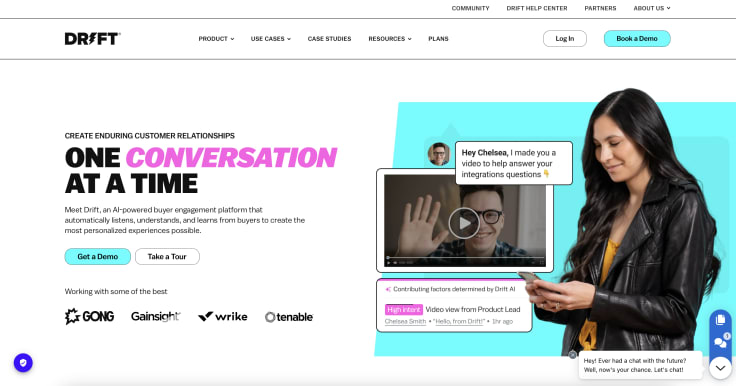
Drift specializes in sales-oriented AI chatbots, helping businesses to efficiently qualify leads and schedule meetings. Known for its innovative features like the Drift Deal Room, which allows team collaboration to close sales and train new reps, Drift integrates with over 50 native platforms and can connect to more than 500 third-party tools via Zapier.
Each plan includes personalized support through a customer success manager, strategy reviews, and onboarding. Drift's pricing structure is not fully transparent, focusing instead on providing tailored solutions that fit the specific needs of businesses of all sizes.
This focus on sales and lead qualification, combined with comprehensive support and integration capabilities, makes Drift a powerful tool for companies aiming to enhance their sales processes through AI-driven interactions.
Tips for getting the most out of your chatbot
It's crucial to choose the right chatbot and keep it finely tuned to really make it work for you.
Here's how you can ensure your chatbot not only meets but exceeds your expectations:
- Choose the right chatbot for your needs: Start by selecting a chatbot platform that aligns with your business's specific needs. Whether you're in ecommerce, finance, or healthcare, the right chatbot can make a big difference by handling tasks and improving customer interactions.
- Explore all features: Once your chatbot is up and running, take the time to explore all of its features. You'd be surprised how many useful tools go unnoticed and unused. Knowing what your chatbot is capable of can help you leverage its full potential.
- Keep your chatbot updated: Continuous improvement is key. Regularly update your chatbot based on company changes, customer feedback, and performance metrics. This keeps the chatbot relevant and highly functional, enhancing user satisfaction.
- Listen to customer feedback: Pay close attention to what your customers are saying about their interactions with the chatbot. Use this feedback to make necessary adjustments, ensuring the chatbot effectively meets user expectations and needs.
By focusing on these aspects, you'll enhance the functionality of your chatbot and see a significant return on your investment through improved customer satisfaction and efficiency.
Transform your business with ChatBot
In essence, chatbots are powerful tools that enhance customer interactions and streamline operations across many industries. By carefully selecting and maintaining a chatbot, businesses can achieve higher efficiency, improved customer satisfaction, and greater insights into customer behavior.
Whether through handling routine inquiries or providing personalized recommendations, chatbots offer a significant return on investment, making them an indispensable asset in today's digital landscape.
Ready to transform your customer interactions with ease? Visit ChatBot today to start your free trial and discover how our AI-driven platform can enhance your business efficiency and customer satisfaction without any coding required!
